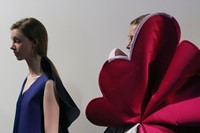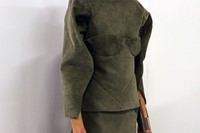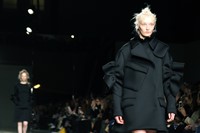Considering strong silhouettes at London Fashion Week
Strength was the key word to summarise London Fashion Week this season: the economic prowess of powerhouses like Burberry and Tom Ford was more obvious than ever, castings moved from the frail Hitchcock blonde to the daring Lynch brunette and designers proved an unwaning individuality even as London asserts itself as a global fashion capital. Silhouettes were diverse and ranged from the slender, minimal and avant-garde to the dramatic and historically-inspired, but they all had one thing in common: they were meant to render women strong, combative, almost hostile.
J.W. Anderson gave in to the lingering midi-hemline trend through bias-cut corduroy and wool skirts that looked purposefully heavy and tortuous. The silhouette might not have been an easy one (opinions on the collection were divided) but it was certainly a strong one. Anderson strives to create new proportions with each one of his collections, and this season – perhaps more than ever – his aim seemed to eerily elongate the shape and to resist the female form. Towards the end of the show, several of his looks featured oversized Obi belts wrapping the models’ torsos, concealing everything from their breasts to the contour of their hips.
"The force of the Christopher Kane woman laid elsewhere: with evident pleasure, the Scottish designer played around with Victorian shapes to render it almost perverse through the use of nylon, knitwear ruffles and puffy volumes"
The force of the Christopher Kane woman laid elsewhere: with evident pleasure, the Scottish designer played around with Victorian shapes to render it almost perverse through the use of nylon, knitwear ruffles and puffy volumes. If his trouser suits and mink-lined nylon coats (or vice-versa) were reminiscent of the aggressive form of Joan Crawford during her film noir days, his silhouette later morphed into A line, 60s-inspired mini dresses adorned with organza panels that opened up like books, creating a surprisingly graphic effect.
Simone Rocha’s silhouette was inspired by Ann Boleyn yet revisited from a punkish point of view. Volumes were impressive and focused alternatively on the hips for dresses and on the arms (particularly above the elbows, through flounced, ruffled, blown-up sleeves rich in drama) for jackets and coats. The result was that of a powerful gamine (Ann Boleyn was, after all, the seductress who wouldn’t put out).
At Thomas Tait the focus was on power dressing via Paris in the 1980s (and Thierry Mugler). There were bold shoulderlines, fitted waistlines and round hips in jackets, rigid bustier tops and coats, while the skirts and trousers were fitted if not skinny, making models look like colourful, Bauhaus-version chairwomen of the board.
Text by Marta Represa
Marta Represa is a freelance writer specialising in fashion, art, photography and culture.



